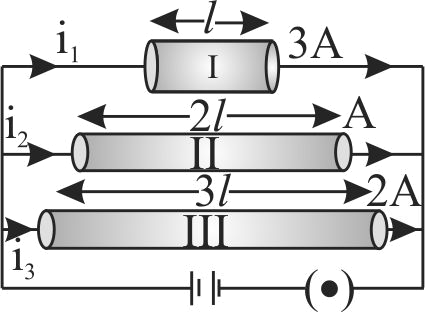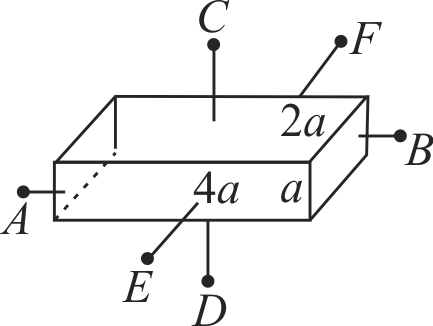357048
The figure shows three conductors I, II and III of same material, different lengths, \({\rm{l,}}2{\rm{l}}\) and \(3{\rm{l}}\) and of different areas of cross-section 3\(A\), \(A\) and 2\(A\) respectively. Arrange them in the increasing order of current drawn from battery.
357050 A metal wire of circular cross-section has a resistance \({{\rm{R}}_{\rm{1}}}\). The wire is now stretched without breaking so that its length is doubled and the density is assumed to remain the same. If the resistance of the wire now becomes \({{\rm{R}}_{\rm{2}}}\) then \({{\rm{R}}_2}:{{\rm{R}}_1}\) is
357051 Two conductors are made of the same material and have the same length. Conductor \(A\) is a solid wire of diameter 1 \(mm\). Conductor \(B\) is a hollow tube of outer diameter 2 \(mm\) and inner diameter 1 \(mm\). What is the ratio of resistance \({R_A}{\rm{to}}\,{R_B}\)?
357048
The figure shows three conductors I, II and III of same material, different lengths, \({\rm{l,}}2{\rm{l}}\) and \(3{\rm{l}}\) and of different areas of cross-section 3\(A\), \(A\) and 2\(A\) respectively. Arrange them in the increasing order of current drawn from battery.
357050 A metal wire of circular cross-section has a resistance \({{\rm{R}}_{\rm{1}}}\). The wire is now stretched without breaking so that its length is doubled and the density is assumed to remain the same. If the resistance of the wire now becomes \({{\rm{R}}_{\rm{2}}}\) then \({{\rm{R}}_2}:{{\rm{R}}_1}\) is
357051 Two conductors are made of the same material and have the same length. Conductor \(A\) is a solid wire of diameter 1 \(mm\). Conductor \(B\) is a hollow tube of outer diameter 2 \(mm\) and inner diameter 1 \(mm\). What is the ratio of resistance \({R_A}{\rm{to}}\,{R_B}\)?
357048
The figure shows three conductors I, II and III of same material, different lengths, \({\rm{l,}}2{\rm{l}}\) and \(3{\rm{l}}\) and of different areas of cross-section 3\(A\), \(A\) and 2\(A\) respectively. Arrange them in the increasing order of current drawn from battery.
357050 A metal wire of circular cross-section has a resistance \({{\rm{R}}_{\rm{1}}}\). The wire is now stretched without breaking so that its length is doubled and the density is assumed to remain the same. If the resistance of the wire now becomes \({{\rm{R}}_{\rm{2}}}\) then \({{\rm{R}}_2}:{{\rm{R}}_1}\) is
357051 Two conductors are made of the same material and have the same length. Conductor \(A\) is a solid wire of diameter 1 \(mm\). Conductor \(B\) is a hollow tube of outer diameter 2 \(mm\) and inner diameter 1 \(mm\). What is the ratio of resistance \({R_A}{\rm{to}}\,{R_B}\)?
357048
The figure shows three conductors I, II and III of same material, different lengths, \({\rm{l,}}2{\rm{l}}\) and \(3{\rm{l}}\) and of different areas of cross-section 3\(A\), \(A\) and 2\(A\) respectively. Arrange them in the increasing order of current drawn from battery.
357050 A metal wire of circular cross-section has a resistance \({{\rm{R}}_{\rm{1}}}\). The wire is now stretched without breaking so that its length is doubled and the density is assumed to remain the same. If the resistance of the wire now becomes \({{\rm{R}}_{\rm{2}}}\) then \({{\rm{R}}_2}:{{\rm{R}}_1}\) is
357051 Two conductors are made of the same material and have the same length. Conductor \(A\) is a solid wire of diameter 1 \(mm\). Conductor \(B\) is a hollow tube of outer diameter 2 \(mm\) and inner diameter 1 \(mm\). What is the ratio of resistance \({R_A}{\rm{to}}\,{R_B}\)?

